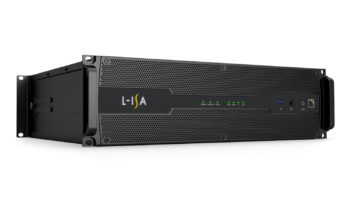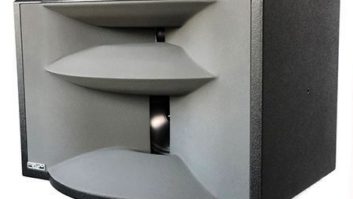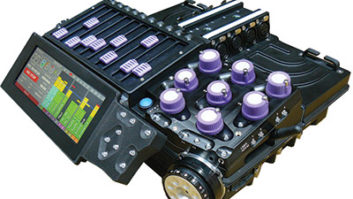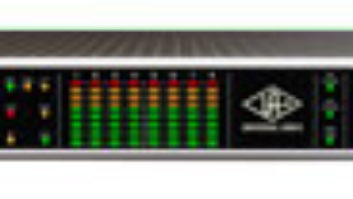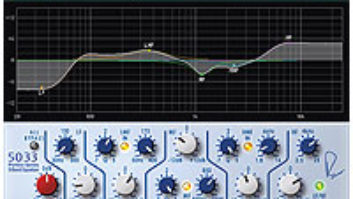by Janice Brown
Producer/engineers and recording musician/composers can all benefit from the bonus plug-in processing power added with DSP acceleration card and eternal box processors. The following end-users have extended their DAW system with at least one such plug-in processor and share how their choice hosts have affected workflow and plug-in usage.
Los Angeles-based engineer Chris Fogel (Blades of Glory, Factory Girl, Mr. Woodcock): “At my studio, Hyperion Sound, we have four rooms–and each of them has some kind of DSP accelerating unit, ranging from Muse Receptor and Universal Audio UAD-1 cards to Macs built specifically as plug-in hosts. For example, in my mix room is a UAD-1 and a G5 that is dedicated for plug-ins, primarily Altiverb, which I use alongside my Lexicon 960 as a traditional aux-style reverb, mostly on orchestras.
“We have a few UAD-1s and find them useful on many things. I particularly like the 140 Plate, the 1176, some of the chorus effects and the Fairchild, which I use on everything from bass and drums to stereo string room compression. As our rooms are equipped with two analog Euphonix consoles, we are still very heavy into hardware, but these soft processors have become an invaluable part of the arsenal.”
Fogel says that the externally powered plug-ins get used more frequently: “Especially Altiverb, which takes up so many resources when not used externally,” he specifies. “I have 8 ins and 16 outs via a MOTU interface, so it’s very powerful, and I get a lot of instances. And it certainly helps the way the composers at Hyperion–Theodore Shapiro and Edward Shearmur–write (in Digital Performer) because it relieves some processor burden and lowers latency.”
Jack HaleNashville-based producer/engineer Jack Hale (Johnny Cash, Zach Liff, Seals & Crofts): “My DSP card is TC Electronic’s PowerCore II. I use the PowerCore version of Sony’s Oxford plug-ins (EQ, Filters, Compressor, Inflator) quite often in conventional ways–compress vocals, EQ a track, etc. I like to use Inflator on kick drum and basses. I have used Assimilator to match tonalities between tracks that were recorded either at different times, [with] different mics, preamps, etc. This can be great for vocal overdubs, especially to compensate for differences in the voice due to allergies, time of day, different mics, and so on. The Master X5 is great for a lot of applications other than mastering. I use the DVR2 (Digital Vintage Reverb) on “organic” acoustic material. I use Fabrik C (3-band compressor) side-chained to other plug-ins.”
Producer/engineer/recording artist (Othyrworld/Sacred Blade) Jeff Ulmer
: “I’m currently using a pair of Waves APA32s, which I share between two workstations. Managing DSP allocation can be a challenge on my TDM system, so I like being able to assign the plug-ins of my choice to the APAs. On the native rig, they allow running plugs that otherwise would choke the system when deep into a mix with a lot of plugs in use. Using the ‘Net’ plug-ins is no different than using the regular versions, and it is seamless switching between them.
“Waves IR-1 is my reverb of choice now. In fact, I went back and remixed the entire Othyrworld album with it once it became available, and numerous instances are on every track on the album. The improvement to the spatial image and depth were a significant improvement to the mix, and really redefined the sound. I used multiple instances of IR-1 on the drums, with different impulse responses (along with the Renaissance compressor and Renaissance EQ). Often when mixing, I will want to have the option of monitoring through a rough mastering stage to see how adjustments to the mix will be affected by the mastering chain. Since I’m usually pushing the limits of the system, the APAs allow for offloading plugs like the Linear Broadband or Lowband EQ and compressor, L3, or C4, which could otherwise overload the host system. Running multiple IR-1s on the APA allows me to use the full CPU versions where I would likely opt for the efficient version running on the host to minimize CPU overhead in a heavy mix.” San Francisco-based artist/producer Miles Fender (Earth Calling Angela and Charlottesville; www.streetlightfarm.com): “I use an SSL Duende and a UAD-1 extensively. Probably my single favorite plug-in is the Duende Channel Strip–I use it on most audio tracks, or if I’m running out of slots, on stems. And I always use the Bus Compressor across the mix to glue everything together–it works like magic. “Of the UAD-1 plug-ins, my favorites are probably the Plate 140 and the Roland Space Echo. The Plate 140 is the best reverb I own, bar none. It nearly always gets used on vocals. The Space Echo works great if there is a piano riff involved.
